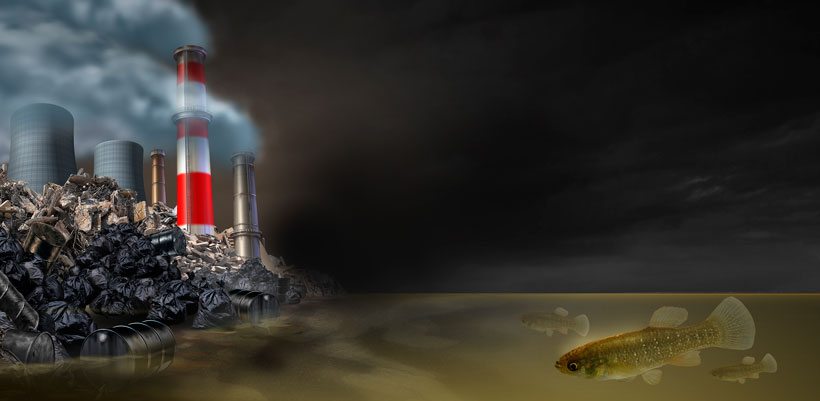No evolution in pollution: killifish survivors are ‘losers’

Atlantic killifish (Fundulus heteroclitus), also known as mud minnows or mummichog, are abundant in the estuarine waters along the Atlantic coast of the USA and Canada. Because they are “typically really sensitive to pollution”, they have for some time been regarded as an environmental indicator species.1 That is, an indicative barometer of the health of ecosystems—the aquatic equivalent of a “canary in the coal mine”.2
However, Atlantic killifish have now been found living at various sites3 in highly polluted waters. This is even in places where the levels of contaminants such as dioxins, mercury, and other industrial chemicals are more than 8,000 times the previously-measured lethal dose for killifish. Their external appearance and behaviour were just the same as killifish living in nearby unpolluted waters.1
When researchers compared the genomes of pollution-tolerant killifish and killifish in nearby unpolluted waters, they found a key difference.4 The pollution-tolerant fish had a common set of mutations. Further analysis showed that in mutant fish, many of those mutations help to deactivate, or turn off, the aryl hydrocarbon receptor signalling pathway. This molecular pathway is responsible for a lot of the abnormal development and larval lethality in normal killifish when polluting contaminants are present. So because the mutated genes turn off that biochemical pathway, mutant killifish can safely live in what would otherwise be toxic waters.
The researchers also discovered that the set of mutations could be found in some of the killifish living in unpolluted waters. However, they say that the fact it was rare there probably indicates these mutations don’t provide any survival advantage for fish when toxins are absent.
Now, what’s all this got to do with the origins debate, the controversy as to whether we were created as the Bible says or instead evolved from microbes over millions and billions of years? Simply this. Despite the researchers’ actual observations (summarized above), their findings were reported as being evidence of evolution. National Geographic headlined: “These fish evolved to live in extremely toxic water”1 and the title of the researchers’ Science paper referred to “rapid repeated evolutionary adaptation”.4
However, there is nothing ‘evolutionary’ in what the researchers observed and documented, in the sense of any evidence of mutation-derived increase in genetic information as microbe-to-man evolution requires. The killifish mutations were already present in the clean-water populations, ready for natural selection to act upon when the environment turned toxic. (Natural selection can only act upon existing genetic information, it can never generate new genes, therefore natural selection is not evolution, despite what the bait-and-switch tactics5 of some textbooks imply.) The mutations did not gain any new function but rather lost function (the turning off of the aforementioned metabolic pathway). So the killifish survivors in polluted waters were actually ‘losers’.
And not just as individuals. The researchers were concerned to see that killifish populations in contaminated areas had lost genetic diversity, compared to the original populations in clean water. As National Geographic put it, “In adapting to their new environment, the pollution-tolerant fish lost a little bit of their genetic capital: They became slightly less diverse.”1 (Presumably that is also because the poison killed the whole pollution-intolerant fish, so eliminated all its genes—not just that for the AHR pathway.) That would make them less able to adapt to future changes in their surrounds compared to the clean-water killifish populations, described by the researchers as having been “well positioned to evolve the necessary adaptations to survive in radically altered habitats.”4 But in this killifish case study the adaptation for living in polluted waters did not ‘evolve’ but was already present. No wonder that the appearance of survivor populations was “rapid” under the natural selection force of lethal toxins.
The killifish were not ‘positioned to evolve’ but rather ‘designed to adapt’. Armed with a loss-of-molecular-pathway adaptation, the ‘losers’ proved to be ‘fittest’. There was no evolution in this pollution!
Re-posted on homepage: 15 September 2021
References and notes
- Konkel, L., These fish evolved to live in extremely toxic water—Killifish in some highly polluted eastern rivers have evolved to survive levels of toxins up to 8,000 times the lethal dose, news.nationalgeographic.com, 8 December 2016. Return to text.
- University of California—Davis, Health defects found in fish exposed to Deepwater Horizon oil spill, caes.ucdavis.edu, 3 May 2013. Return to text.
- New Bedford Harbor in Massachusetts, Newark Bay in New Jersey, the Bridgeport area of Connecticut, and the Elizabeth River in Virginia. Return to text.
- Reid, N., and 11 others, The genomic landscape of rapid repeated evolutionary adaptation to toxic pollution in wild fish, Science 354(6317):1305–1308, 2016. Return to text.
- In many textbooks the terms ‘natural selection’ and ‘evolution’ are frequently used as synonyms, which they demonstrably are not. See, e.g., Ambler, M., Natural selection ≠ evolution, Creation 34(2):38–39, 2012; creation.com/nse, and: Walker, T., Don’t fall for the bait and switch—sloppy language leads to sloppy thinking, Creation 29(4)38–39; creation.com/baitandswitch. Return to text.







Readers’ comments
Comments are automatically closed 14 days after publication.